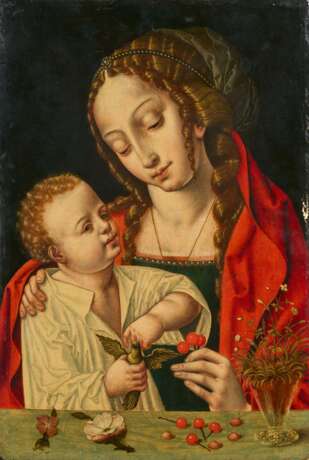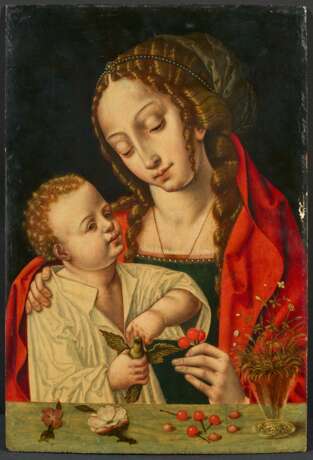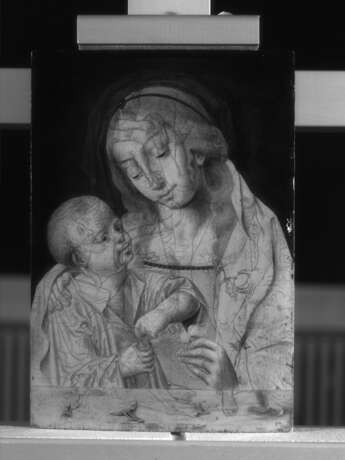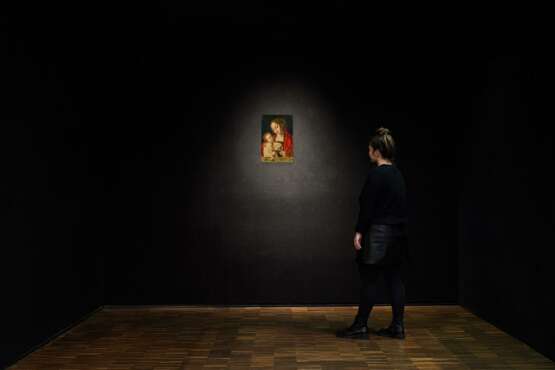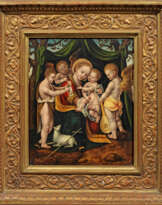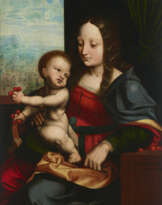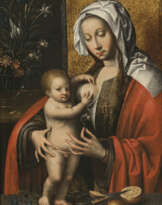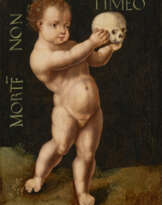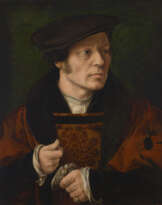ID 950849
Lot 1 | Joos van Cleve
Estimate value
€ 20 000 – 30 000
ca. 1485 Cleves - 1541 Antwerp
Circle
Title: Madonna of the Cherries.
Date: Ca. 1540-1550.
Technique: Oil on wood.
Measurement: 45,5 x 31cm.
Provenance:
Private ownership, Germany.
Separated from the viewer by a railing, a mother gazes lovingly at her child and hands him cherries. This could be an everyday scene from the 16th century, if certain elements did not indicate that it was the Virgin Mary and Jesus. The cherries lying on the parapet and offered by the mother to the child are, by their heart-shaped form and colour, a symbol of Christ's love and his blood shed on the cross. The cherry, juicy and sweet, is also an allusion to the fruit of the tree of Eden, which led to the expulsion of Adam and Eve from the Garden of Eden. The rose also has the double meaning of the blood shed on the cross but at the same time of God's goodness and the grace he bestows on man. Finally, the green parrot that the child holds in his right hand is another Christian symbol: the animal is often used as a symbol for the Annunciation of the Archangel Gabriel to Mary because, according to one tradition, the parrot could say the Ave because of its ability to speak, which would connect it to the Annunciation.
This, then, is a small-format painting peppered with symbols that the 16th-century viewer could effortlessly decipher, whereas they are more difficult to contextualise in the eyes of modern people.
The author of this magnificent depiction of the Madonna and Child is to be found in the workshop or under in the circle of Joos (or Joost) van Cleve. Van Cleve was one of the most important artists of the Antwerp School, mainly active in the years 1515-1530. He is best known for his portraits and paintings with religious themes: his works were in great demand for public and private devotion. Some of his Madonnas with Child bear a strong resemblance to the present painting, which can therefore be assumed to date from around 1540-1550. It seems that at least two artists were involved in the execution of this painting, or at least there were two phases of execution, since microscopic analysis revealed non-negligible differences in the way the yellow pigment was applied. It is likely that a very experienced painter from the workshop of Joos van Cleve painted the Madonna while the child is the work of a pupil or another artist who took over the work (perhaps due to the death of the first painter).
Infrared reflectography revealed an underlying drawing of a dry, dark-coloured material depicting Adam and Eve with the seductive serpent. Eve stands in a landscape and takes an apple from the snake with her right hand; in her left hand she holds a second apple. Adam sits in front of her and stretches out his right arm towards Eve. The x-ray revealed that the composition with Adam and Eve was not painted in oil while the Madonna and the child were painted separately without significant pentimenti.
Identifying the underlying drawing reveals a very common practice of reusing material, where the initial idea was abandoned and the material was reused afterwards to save money. Curiously, the two subjects, original sin and the Madonna handing the cherries to the child, are closely linked by the symbolism of the fruits - apple and cherries - which allude to sin and the redemption of man through the sacrifice of the Son of God.
The painting was examined at the Technische Schule Köln using various non-destructive methods of analysis to gain a better understanding of the materials and techniques used, as well as its condition:
Stereomicroscopy,
Infrared reflectography (Osiris, 900-1700nm) in 2018,
UV light examination and X-ray (Seifert ERESCO 150KV/0.5mA / Examion CR 3X-pro) XRF analysis (Niton XLt).
The examination report, prepared in Cologne on 10.03.2020, is available.
We are grateful to Suzanne Laemers, RKD, The Hague, and Maryan Ainsworth, New York, for their kind assistance in cataloguing the present painting.
| Artist: | Joos van Cleve (1485 - 1540) |
|---|---|
| Applied technique: | Oil |
| Auction house category: | Old Masters |
| Artist: | Joos van Cleve (1485 - 1540) |
|---|---|
| Applied technique: | Oil |
| Auction house category: | Old Masters |
| Address of auction |
VAN HAM Kunstauktionen GmbH Hitzelerstr. 2 50968 Köln Germany | ||||||||||||||
|---|---|---|---|---|---|---|---|---|---|---|---|---|---|---|---|
| Preview |
| ||||||||||||||
| Phone | +49 221 92586215 | ||||||||||||||
| Fax | +49 221 92 58 62 4 | ||||||||||||||
| Buyer Premium | 32% | ||||||||||||||
| Conditions of purchase | Conditions of purchase | ||||||||||||||
| Business hours | Business hours
|
